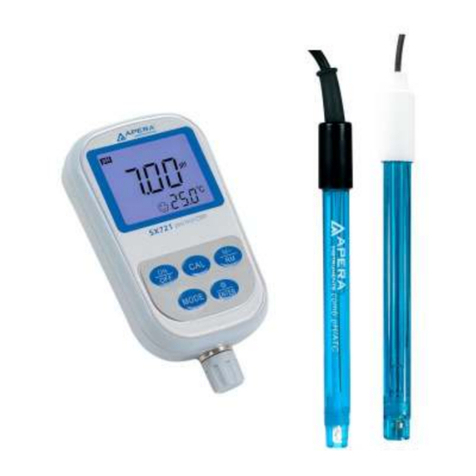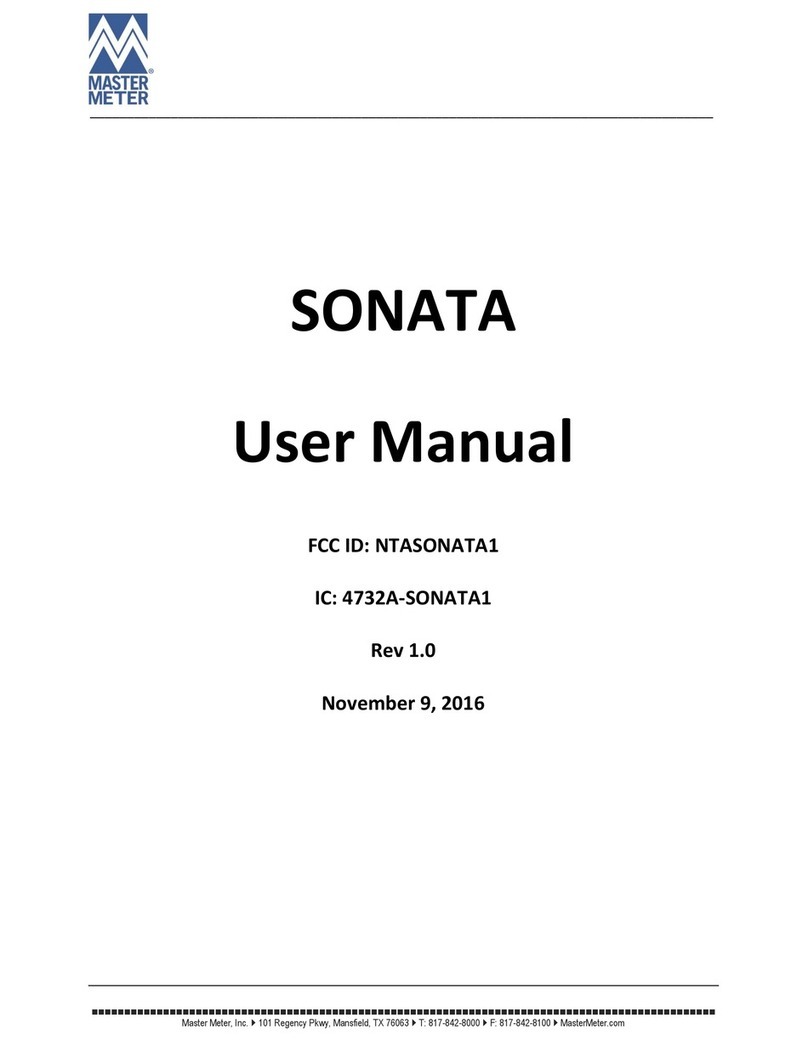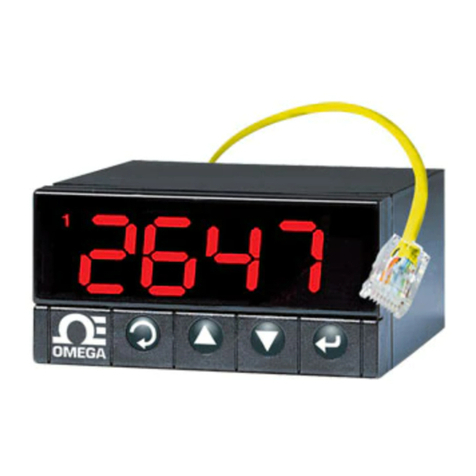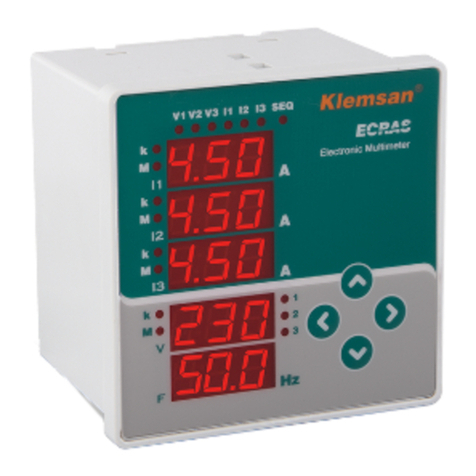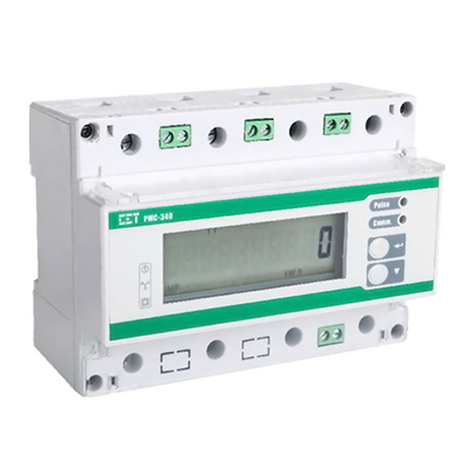IET Labs, Inc. 1864-1644 Troubleshooting guide

1864-1644
Positive Polarity
Megohmmeter
User and Service Manual
Copyright © 2018 IET Labs, Inc.
Visit www.ietlabs.com for manual revision updates
1864-1644 im/January 2018
♦PRECISION INSTRUMENTS FOR TEST AND MEASUREMENT ♦
Email: inf[email protected]
TEL: (516) 334-5959 • FAX: (516) 334-5988
www.ietlabs.com
IET LABS, INC.

♦PRECISION INSTRUMENTS FOR TEST AND MEASUREMENT ♦
Email: inf[email protected]
TEL: (516) 334-5959 • FAX: (516) 334-5988
www.ietlabs.com
IET LABS, INC.

WARRANTY
We warrant that this product is free from defects in material and workmanship and, when properly used,
will perform in accordance with applicable IET specifications. If within one year after original shipment,
it is found not to meet this standard, it will be repaired or, at the option of IET, replaced at no charge when
returned to IET. Changes in this product not approved by IET or application of voltages or currents greater
than those allowed by the specifications shall void this warranty. IET shall not be liable for any indirect,
special, or consequential damages, even if notice has been given to the possibility of such damages.
THIS WARRANTY IS IN LIEU OF ALL OTHER WARRANTIES, EXPRESSED OR IMPLIED,
INCLUDING BUT NOT LIMITED TO, ANY IMPLIED WARRANTY OF MERCHANTABILITY OR
FITNESS FOR ANY PARTICULAR PURPOSE.

WARNING
OBSERVE ALL SAFETY RULES
WHEN WORKING WITH HIGH VOLTAGES OR LINE VOLTAGES.
Dangerous voltages may be present inside this instrument. Do not open the case
Refer servicing to qualified personnel
HIGH VOLTAGES MAY BE PRESENT AT THE TERMINALS OF THIS INSTRUMENT
WHENEVER HAZARDOUS VOLTAGES (> 45 V) ARE USED, TAKE ALL MEASURES TO
AVOID ACCIDENTAL CONTACT WITH ANY LIVE COMPONENTS.
USE MAXIMUM INSULATION AND MINIMIZE THE USE OF BARE
CONDUCTORS WHEN USING THIS INSTRUMENT.
Use extreme caution when working with bare conductors or bus bars.
WHEN WORKING WITH HIGH VOLTAGES, POST WARNING SIGNS AND
KEEP UNREQUIRED PERSONNEL SAFELY AWAY.
CAUTION
DO NOT APPLY ANY VOLTAGES OR CURRENTS TO THE TERMINALS OF THIS
INSTRUMENT IN EXCESS OF THE MAXIMUM LIMITS INDICATED ON
THE FRONT PANEL OR THE OPERATING GUIDE LABEL.

CONTENTS, FIGURES, AND TABLES
1864-1644 Positive Polarity Megohmmeter
i
Contents
Condensed Operating Instructions..........................................................iv
Specifications.............................................................................................v
1864-1644 Specifications............................................................................................... v
Chapter 1: INTRODUCTION.......................................................................1
1.1 Description............................................................................................................... 1
1.2 Opening and Tilting the Cabinet .............................................................................. 1
1.3 Controls, Connectors and Indicators........................................................................ 1
1.4 Symbols.................................................................................................................... 5
1.5 Connections.............................................................................................................. 5
Chapter 2: INSTALLATION.........................................................................7
2.1 Initial Inspection ...................................................................................................... 7
2.2 Dimensions .............................................................................................................. 7
2.3 Repackaging for Shipment....................................................................................... 7
2.4 Storage ..................................................................................................................... 8
2.5 Bench Setup ............................................................................................................. 8
2.6 Rack Mounting......................................................................................................... 8
2.7 Power Connections .................................................................................................. 8
Chapter 3: OPERATION .............................................................................9
3.1 Measurement Setup................................................................................................. 9
3.1.1 Ground-Link Connection............................................................................... 9
3.1.2 Test Voltage Selection.................................................................................... 9
3.1.4 Connection of Unknown................................................................................ 9
3.2 Measurement Procedure ................................................................................... 10
3.2.1 General........................................................................................................... 10
3.2.2 Search Procedure ........................................................................................... 10
3.2.3 Sort Procedure ............................................................................................... 10
3.2.4 Shock Hazard ................................................................................................ 10
3.3 Output Jack .............................................................................................................. 11
Chapter 4: APPLICATIONS........................................................................13
4.1 Insulation Testing..................................................................................................... 13
4.2 Test Sample Resistivity Measurements.................................................................... 14
4.3.1 General........................................................................................................... 14
4.3.2 Charging Time Constant ................................................................................ 14

CONTENTS, FIGURES, AND TABLES
1864-1644 Positive Polarity Megohmmeter
ii
4.3.3 Measurement Time Constant ......................................................................... 15
4.3.4 Discharge Time.............................................................................................. 15
4.3.5 Large Capacitors, Very High Resistance ....................................................... 15
4.4 Resistance Measurements ........................................................................................ 16
4.5 Measurement of Voltage Coefficient........................................................................ 16
4.6 Guarded 3-Terminal Measurements......................................................................... 17
4.7 Remote Shielded Measurements.............................................................................. 17
4.8 Measurements Under Humid Conditions................................................................. 17
Chapter 5: THEORY....................................................................................19
5.1 General.................................................................................................................... 19
5.2 Circuit Description................................................................................................... 19
5.2.1 General........................................................................................................... 19
5.2.2 Type 1863 Megohmmeter (Figure 7.6).......................................................... 19
5.2.3 Type 1864 Megohmmeter (Figure 7.9).......................................................... 20
Chapter 6: SERVICE AND MAINTENANCE ..............................................21
6.1 Service...................................................................................................................... 21
6.3 Cabinet Removal...................................................................................................... 23
6.4 Troubleshooting ....................................................................................................... 23
6.4.1 General........................................................................................................... 23
6.4.2 Test Voltages .................................................................................................. 24
6.5 Calibration Procedure .............................................................................................. 24
6.5.1 General........................................................................................................... 24
6.5.2 Meter Tracking............................................................................................... 24
6.5.3 Voltage Accuracy .................................................................................................. 24
6.5.4 Range-Resistor Accuracy............................................................................... 25
6.5.5 Coarse Adjustment..................................................................................... 25
6.6 Knob Removal ......................................................................................................... 26
6.7 Knob Installation...................................................................................................... 27
6.8 Meter Cover Care..................................................................................................... 27
Chapter 7: PARTS LISTS AND DIAGRAMS ..............................................29

CONTENTS, FIGURES, AND TABLES
1864-1644 Positive Polarity Megohmmeter
iii
Figures
1864-1644 Front-panel Controls, Connectors and Indicators................................. iv
Figure 1-1. Type 1864-1644 Front-panel Controls, Connectors and Indicators ..... 2
Figure 1-2. Type 1864-1644 rear-panel controls and connectors .......................... 4
Figure 1-3. Methods of connection to the measurement terminals ........................ 5
Figure 2-1. Dimensions of the GR/IET 1864-1644 Megohmmeters...................... 7
Figure 3-1 Ground-link connection to GUARD and to -UNKNOWN terminals... 9
Figure 4-1. Electrode arrangement for resisitivity measurements......................... 14
Figure 4.2 Basic megohmmeter circuit................................................................... 15
Figure 4-3. Guarded measurement of a three-terminal resistor.............................. 16
Figure 5-1 Megohmmeter block diagram ............................................................... 20
Figure 6-1. Connections for measuring standard resistors ..................................... 22
Figure 6-2. Top interior view of 1864 Megohmmeter ........................................... 26
Figure 6-3. Bottom interior view of 1864 Megohmmeter ...................................... 26
Figure 7-1. Replaceable mechanical parts on the 1864-1644................................. 31
Figure 7-3. Type 1864 rectifier circuit etched-board assembly .............................. 32
Figure 7-2. Regulator and amplifier circuits etched-board assembly ..................... 32
Figure 7-4 Type 1864 switching diagram ............................................................... 33
Figure 7-5. Type 1864 schematic diagram.............................................................. 34
Figure 7-6. Complete cabinet assembly.................................................................. 35

CONTENTS, FIGURES, AND TABLES
1864-1644 Positive Polarity Megohmmeter
iv
1. Determine which ground link connection is to be
used (paragraph 3.1.1 ).
2. Set the TEST VOLTAGE switch(es) to the proper
voltage (paragraph 3.1.2).
3. Set the ∞adjustments (paragraph 3.1.3).
Condensed Operating Instructions
4. Connect the unknown to the UNKNOWN termi-
nals.
5. Measure the unknown with either the search (para-
graph 3.2.2) or sort (paragraph 3.2.3) procedure.
SET ∞
HIGHEST RANGE SET ∞GUARD - UNKNOWN +
GROUND
MULTIPLIER
DIAL
FUNCTION
SWITCH
TEST-VOLTAGE
SWITCHES
POWER-OFF
SWITCH
1864-1644 Front-panel Controls, Connectors and Indicators

CONTENTS, FIGURES, AND TABLES
1864-1644 Positive Polarity Megohmmeter
v
Specifications
1864-1644 Specifications
Resistance Accuracy (min reading 0.5):
Range 1-5:
±2 (meter reading+1)%
Where meter reading is the actual number
indicated at the scale; e.g. for a reading of
900 kon the 1 Gscale, the accuracy is
±2(.9+1)% or 3.8%
Range 6:
add ±2% to accuracy above
Range 7:
add ±3% to accuracy above
Range 8:
add ±5% to accuracy above
Accuracy applies for >100 V;
For 100 V add 2%.
Meter Display:
Full mechanical zero at right end, so 2.5 % full-
scale is near right end and full-scale is at left end.
However, resistance values read naturally, increas-
ing from left to right.
Voltage Accuracy (across unknown):
For 100 V ± 2%
For <100 V ± (3% + 0.5 V)
(10% of scale)
("5" rdg)
(2.5% of scale)
("20" rdg)
10 Vdc to 50 Vdc 50 k500 G2 T*7
50 Vdc to 100 Vdc 200 k5 T20 T8
100 Vdc to 500 Vdc 500 k5 T20 T*7
500 Vdc to 1090 Vdc 5 M50 T200 T8
*Recommended Limit
Rmin
(Full Scale left end)
("0.5" rdg)
Rmax (right end)
Voltage
Setting
Useful
Ranges
Short-Circuit Current:
Approximately 5 mA
Power:
100 - 125 or 200 - 250 V
50 - 400 Hz
13 W
Fuse:
For 100 to 125 V operation:
Fuse: T 0.25A, 250V (PN 0034.3111)
For 200 to 250 V operation:
Fuse: T 0.125A, 250V (PN 0034.3108)
Fuse holder is located under the IEC receptacle and
holds a 5 x 20 mm time-delay fuse.
Dimensions:
6.63 x 10 x 6.75 in.
Weight:
9.5 lb.

CONTENTS, FIGURES, AND TABLES
1864-1644 Positive Polarity Megohmmeter
vi
This page intentionally left blank.

INTRODUCTION
1864-1644 Positive Polarity Megohmmeter
1
Chapter 1
INTRODUCTION
1.2 Opening and Tilting the Cabinet
To open the cabinet, refer to the pictorial graphic on
the rear panel of the unit; see Figure 1-2. The Flip-Tilt
cabinet can be opened by placing the instrument on
its rubber feet with the handle away from you. Push
down on the handle and the instrument, located in the
upper part of the case, will rotate to a vertical position.
While holding the handle down with one hand, rotate
the instrument to the desired position with the other
hand and then slowly release the handle.
1.3 Controls, Connectors and Indicators
Figure 1-1 shows the front-panel controls, connectors
and indicators of the 1864. Table 1-1 lists and identi-
fies them. Figure 1-2 shows the rear panel controls and
connectors, and Table 1-2 lists and identifies them.
1.1 Description
The 1864-1644 (Figure 1-1) indicates resistance
from 50 kto 200 T. These ranges are suitable for
leakage-resistance measurements of most types of
insulation used in electrical instruments, electronic
devices and components, etc (Section 4). The 1864
has a voltage range from 10 to 1090 V that can be set
in 1 Vdc steps from 10 to 109 V, and in 10 V steps
from 100 to 1090 V by using the TEST VOLTAGE
switches on the front panel.
The 100-volt setting is the EIA standard for measure-
ment of composition, film, and wire-wound resistors
above 100 kilohms. The 500-volt setting is a standard
value in the measurement of the insulation resistance
of rotating machinery, transformers, cables, capaci-
tors, appliances, and other electrical equipment.
A regulated power supply and charging circuit per-
mit rapid and accurate measurement of the leakage
resistance of capacitors.
Guard and ground terminals permit measurement
of grounded or ungrounded two-or three-terminal
resistors.
A panel warning light indicates when voltage is ap-
plied to the test terminals and alerts users to the safe
operation of the instrument.
WARNING
High voltage is applied to the measurement terminals of
1864-1644 Megohmmeters at all times, except when the
function switch is set to DISCHARGE. While the current
is limited to a value that is not dangerous under most
conditions, the energy stored in a capacitor connected
to the terminals may be LETHAL. Always set the function
switch to DISCHARGE before you connect or disconnect
the unknown.

INTRODUCTION
1864-1644 Positive Polarity Megohmmeter
2
Figure 1-1. Type 1864-1644 Front-panel Controls, Connectors and
Indicators
1
2
34
7
6
11
10
9
8
5
12

INTRODUCTION
1864-1644 Positive Polarity Megohmmeter
3
Figure 1.1
Reference
Name Type Function
1POWER
OFF
2-position toggle
switch Turn power on and off.
2 Meter 4-in. meter with
plastic cover
Indicates the value to be
multiplies by the multiplier
switch.
3SET ∞
HIGHEST RANGE
Knob-rotated
control
Adjusts high end of meter
scale on highest resistance
range to compensate for offset
current.
4 SET ∞Knob-rotated
control
Adjusts high end of meter
scale on highest resistance
range to compensate for offset
voltage in the voltmeter.
5 GUARD Insulated binding
post
For guarded measurements. It
can accept a shorting link to
the ground post.
6 Ground Uninsulated
binding post
Grounds the Unknown- or
guard. Contains a shorting
link.
7 UNKNOWN - Insulated binding
post
Connects the - side of the
unknown to the megohmmeter.
8 UNKNOWN + Insulated binding
post
Connects the + side of the
unknown to the megohmmeter.
9 DANGER Indicated light
shaded red
Glows red when the function
switch is in the CHARGE or
MEASURE position.
10 Multiplier 8-position rotary
switch Selects resistance range.
11
MEASURE
CHARGE
DISCHARGE
3-position toggle
switch
Selects the operating position
applied to the unknown.
12 TEST VOLTAGE
3 rotary switches:
10-position
9-position
2-position
Select voltage in 1-V steps
from 10 to 109 V and in 100-V
steps from 100 to 1090 V.

INTRODUCTION
1864-1644 Positive Polarity Megohmmeter
4
Figure 1-2. Type 1864-1644 rear-panel controls and connectors
Figure 1-2
Reference
Name Type Function
1Power Input IEC Standard
Power input
receptacle.
Power input and circuit protection
2Output Phone jack Provides a dc voltage output for recorder
operation
3Line Voltage 2-position slide
switch
Connects wiring of power transformer for
either 100 to 125 V or 200 to 250 V input
41/8 Amp Integral fuse
holder
Holder for 5 x 20 mm
For 100 to 125 V operation: 1/4 A fuse
For 200 to 250 V operation: 1/8 A fuse
Table 1.2.
1
2
3
4

INTRODUCTION
1864-1644 Positive Polarity Megohmmeter
5
1.4 Symbols
These instruments indicate the resistance of the
unknown in multiples of ohms. The relationship
between ohms (), kilohms (k), megohms (M),
gigaohms (G), and teraohms (T) is as follows:
1 MΩ= 106 Ω= 103 kΩ
I GΩ= 109 Ω= 106 kΩ= 103MΩ
1 TΩ= 1012 Ω= 109kΩ= 106MΩ= 103GΩ
1.5 Connections
The UNKNOWN, GUARD and ground terminals
are standard 3/4-in. spaced binding posts that accept
banana plugs, standard telephone tips, alligator clips,
crocodile clips, spade terminals and all wire sizes up
to number eleven (Figure 1-3).
When several measurements of components with
leads are to be made, consult IET for an appropriate
test jig or fixture.
Figure 1-3. Methods of connection to the measurement terminals

INTRODUCTION
1864-1644 Positive Polarity Megohmmeter
6
This page intentionally left blank.

INSTALLATION
1864-1644 Positive Polarity Megohmmeter
7
Chapter 2
INSTALLATION
2.1 Initial Inspection
IET instruments receive a careful mechanical and
electrical inspection before shipment. Upon receipt,
verify that the contents are intact and as ordered.
The instrument should then be given a visual and
operational inspection.
If any shipping damage is found, contact the carrier
and IET Labs. If any operational problems are en-
countered, contact IET Labs and refer to the warranty
at the beginning of this manual.
Save all original packing material for convenience
in case shipping of the instrument should become
necessary.
2.2 Dimensions
The dimensions of the 1864-1644 are shown in
both the rack and bench-mounted configurations in
Figure 2-1.
2.3 Repackaging for Shipment
If the instrument is to be returned to IET Labs, contact
the Service Department at the number or address,
shown on the front cover of this manual, to obtain a
“Returned Material Authorization” (RMA) number
and any special shipping instructions or assistance.
Proceed as follows:
1. Attach a tag with the following:
• Owner’s Name
• Model Number
• Serial Number
• RMA Number
2. Wrap the instrument in heavy paper or
plastic.
3. Protect the front panel and any other protru-
sions with cardboard or foam padding.
4. Place instrument in original container or
equally substantial heavy carton.
5. Use packing material around all sides of
instrument.
6. Seal with strong tape or bands.
7. Mark shipping container “DELICATE IN-
STRUMENT,” “FRAGILE,” etc.
Figure 2-1. Dimensions of the GR/IET 1864-1644 Megohmmeters
Dimensions in inches

INSTALLATION
1864-1644 Positive Polarity Megohmmeter
8
2.4 Storage
If this instrument is to be stored for any lengthy
period of time, it should be sealed in plastic and
stored in a dry location. It should not be subjected
to temperature extremes beyond the specifications.
Extended exposure to such temperatures can result
in an irreversible change in resistance, and require
recalibration.
2.5 Bench Setup
The bench (portable) model of the megohmmeter
is cased in a Flip-Tilt cabinet. The cabinet opens by
pushing down on the handle and tipping the instru-
ment into the desired operating position (paragraph
1.2).
2.6 Rack Mounting
Consult IET Labs.
2.7 Power Connections
The 1864-1644 Megohmmeter can be operated from
either a 100- to 125-V or a 200- to 250-V, 50-to 60-
Hz power line. Before connecting the 3-wire IEC
power cord to the line, set the slide switch on the rear
panel to the proper setting as indicated by the position
of the white line on the slide switch. The slide can
be actuated with a screwdriver blade. Verify that the
correct size fuse for the input voltage selected has
been installed (1/4 A slow blow for 100-125 V input
or 1/8 A slow blow for 200-250 V input). If it is neces-
sary to use a 3-wire adaptor plug, make certain that
the third wire is connected to a good ground (water
pipe or equivalent). If this is not possible, connect
the panel of the 1864-1644 (uninsulated binding
post) to a good ground. Plug the supplied IEC power
cord into the instrument into a power receptacle. The
power cord may of course be selected to match the
available receptacle.

OPERATION
1864-1644 Positive Polarity Megohmmeter
9
Chapter 3
OPERATION
3.1 Measurement Setup
3.1.1 Ground-Link Connection
The grounding link connected to the uninsulated,
grounded, binding post can be connected from this
ground terminal to the GUARD (paragraph 4.6) or
the -UNKNOWN terminal (Figure 31). The ground
link should be connected to the GUARD terminal if
the sample to be measured is a small, separate compo-
nent, or if it is a component mounted in an enclosure
that should be guarded (see paragraph 4.6). However,
if one terminal of the unknown must be grounded,
then the link should tie the -UNKNOWN terminal
to the instrument case. See Figure 3.1.
3.1.2 Test Voltage Selection
The TEST VOLTAGE switch(es) should be set to
the desired measurement voltage. The 1864-1644
Megohmmeter has a selection of 10 to 109 Vdc in
1-V steps or 100 to 1090 Vdc in 10-V steps. On the
1864, the right-hand TEST VOLTAGE switch must
be set to the Vposition for the low voltages and to
the 0 V position for the high voltages.
Figure 3-1 Ground-link connection to GUARD
terminal (top) and to -UNKNOWN terminal (bottom)
+-
+-
3.1.3 Set ∞Adjustments
To adjust the SET ∞controls, proceed as follows:
1. Turn the instrument on.
2. Set the function switch to DISCHARGE.
3. Set the multiplier dial to any range.
4. Make certain that there nothing is connected
to the UNKNOWN terminals.
5. Adjust the SET ∞control for an ∞reading
on the meter.
6. Set the multiplier switch to 10-1T
7. Set the function switch to MEASURE.
8. Adjust the SET ∞HIGHEST RANGE for an
∞meter reading.
If this adjustment cannot be made electrically, turn
the instrument off, and adjust the mechanical meter
zero adjustment (the center screw on the meter) to
give a meter reading of less than a line width beyond
∞. Repeat steps 1 through 7.
3.1.4 Connection of Unknown
Small components should be connected directly to
the UNKNOWN terminals. Insulated leads can be
connected to a nearby unknown; however, if the un-
known resistance is high, leakage between the leads
will cause a measurement error, and a change in ca-
pacitance to the high lead will cause a transient meter
deflection. For such high resistance measurements, a
shielded system is preferable (refer to paragraph 4.7).

OPERATION
1864-1644 Positive Polarity Megohmmeter
10
3.2 Measurement Procedure
3.2.1 General
Either of two measurement procedures may be used,
depending on whether or not the correct resistance-
multiplier range is known. If the range is not known,
the search procedure (paragraph 3.2.2) should be
followed. If repetitive measurements are to be made
on a given range (i.e., if similar components are to be
sorted) the sort procedure (paragraph 3.2.3) should
be used.
3.2.2 Search Procedure
When the approximate resistance of the sample to be
measured is not known, proceed as follows:
1. Set the multiplier switch to the lowest range.
2. Set the function switch to DISCHARGE.
3. Connect the unknown between the UN-
KNOWN + and - terminals.
4. Set the function switch to MEASURE.
5. Rotate the multiplier switch cw until the
meter gives a reading of less than 5.
6. The resistance of the unknown is the meter
reading multiplied by the multiplier-switch
indication.
7. Make measurements towards the low end of
the meter scale whenever possible, for best
accuracy and resolution.
3.2.3 Sort Procedure
When the approximate resistance of the unknown is
known, proceed as follows:
1. Set the function switch to DISCHARGE.
2. Set the multiplier switch to the desired
range.
3. Connect the unknown between the UN-
KNOWN +and -terminals.
4. Set the function switch to MEASURE.
5. The resistance of the unknown is the meter
reading multiplied by the multiplier-switch
indication. For go-no-go checks, it can be
useful to make high-and-low limit lines on
the outside of the meter case with strips of
masking tape.
6. Make measurements towards the low end of
the meter scale whenever possible, for best
accuracy and resolution.
3.2.4 Shock Hazard
Every precaution has been taken in the design of
1864 Megohmmeters to reduce the possibility of
shock. However, high voltage must be present at
the terminals to make measurements at the required
voltage levels, and the operator should be aware of
the dangers involved.
The current delivered by the megohmmeters under
short-circuit conditions is approximately 5 mA. This
5-mA current is not lethal to most persons but might
be lethal to those with poor hearts, and it is painful to
all. The actual current that will flow through a person
depends on the resistance of the part of the body that
makes contact with the terminals. This resistance can
be as low as 300 Ω. Note that any of the three insulated
binding posts can be at high voltage, depending on
the position of the shorting link.
When capacitors are tested there is an especially dan-
gerous condition because a charged capacitor easily
can have enough energy to cause heart fibrillation
and death. The capacitor should always be shunted
before connection to the megohmmeter, and the func-
tion switch should be set to DISCHARGE for a few
seconds before the capacitor is disconnected.
We strongly recommend that additional precautions,
such as rubber gloves and insulated benchtops, chairs
and shoes should be used for anyone making repeti-
tive measurements with the megohmmeter, particu-
larly measurements on capacitors. These precautions
should not take the place of careful discharge of the
capacitors before and after measurement, but should
be used as an additional safety measure.
Table of contents
Popular Measuring Instrument manuals by other brands
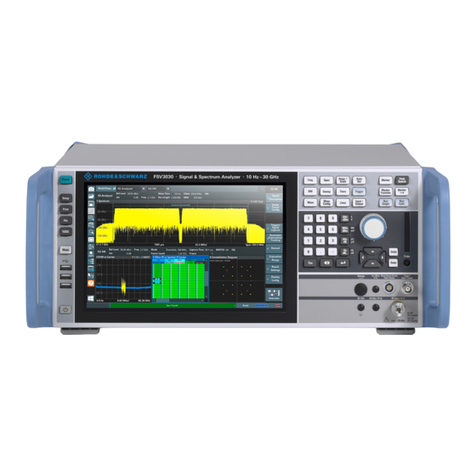
Rohde & Schwarz
Rohde & Schwarz FSVA3000 Getting started
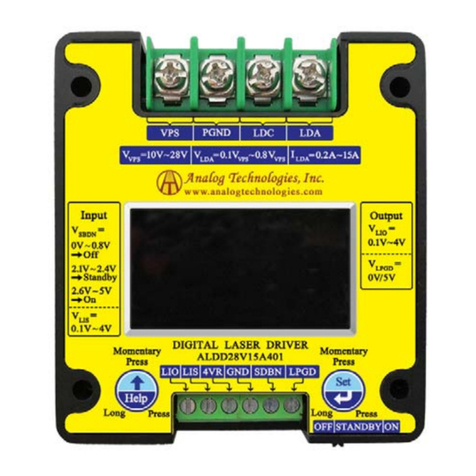
Analog Technologies
Analog Technologies ALDD28V15A401 quick start guide

Maeraj
Maeraj PHV-20 Instruction manual and safety instructions
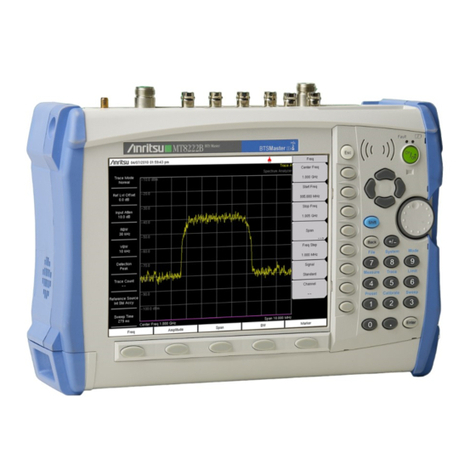
Anritsu
Anritsu BTS Master MT8221B user guide
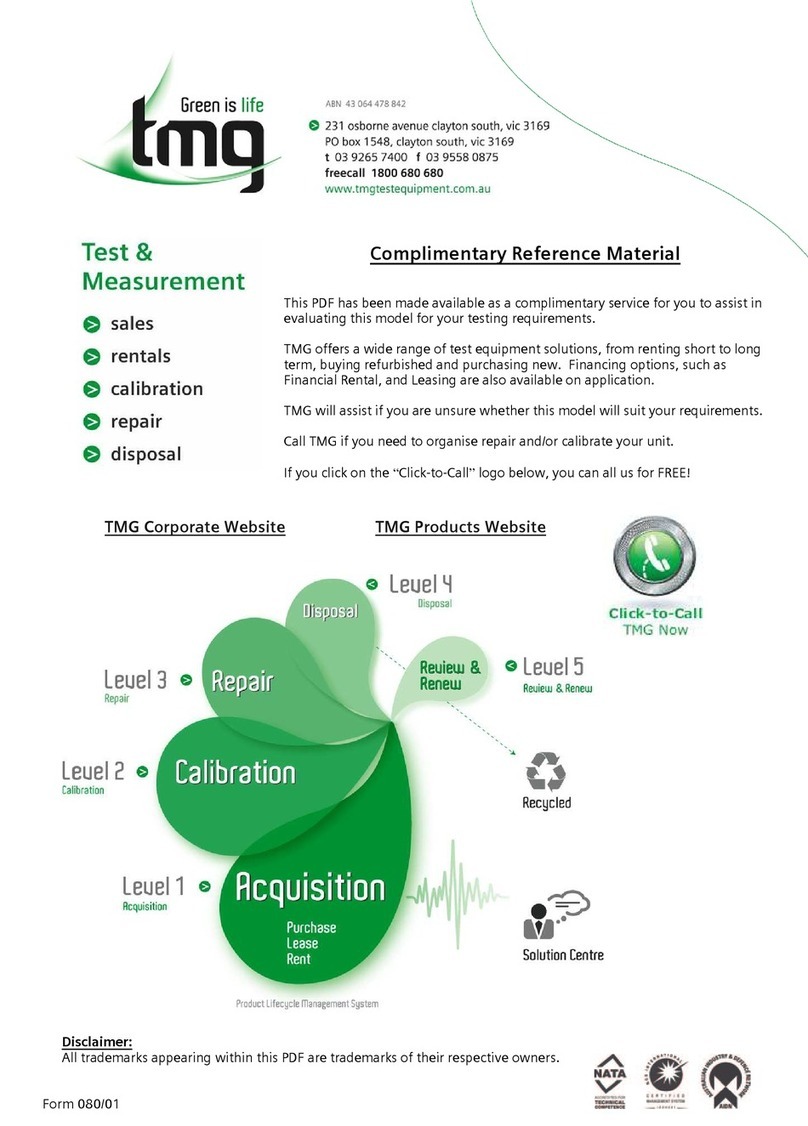
Anritsu
Anritsu Site Master S114C user guide

HT Italia
HT Italia GSC53N instruction manual

